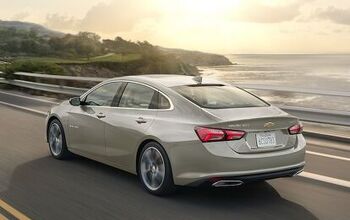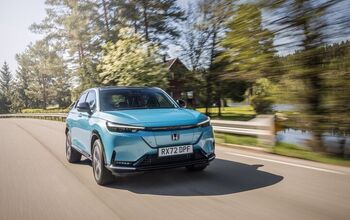Michigan Testing Shows Fairly Innocuous Weather Baffles Self-driving Car Systems

Successfully operating self-driving cars on crowded, complex roadways in sunny, dry locales like Phoenix, Arizona is already enough of a challenge, but researchers in the cold, tempestuous climes of Michigan have revealed what the latest and greatest autonomous technology is really up against.
Rain, sometimes hard rain. But also light rain. Also: cold temperatures, and trees with leaves that fall off in the winter. Given that so few places in the world boast such extreme weather and vegetation anomalies as Michigan, this won’t pose a problem for the widespread proliferation of driverless cars, will it?
While adverse climatic conditions can wreak havoc on cars, decades of testing and development have yielded batteries that crank harder, wipers that turn on at the first touch of rain, and an endless list of other stress-relieving advances. For driverless cars, it’s still the Wild West. Early days.
The proximity of Detroit Three HQs and development centers means Michigan State University finds itself at the center of things on this new frontier. There’s already a driverless car test facility, and school created the CANVAS program (Connected and Autonomous Networked Vehicles for Active Safety) to study how well the driving systems handle the tasks of avoiding things they shouldn’t hit. Part of that research included analyzing how weather impacts the sensor arrays and cameras used to guide the vehicles.
While MSU’s findings will soon appear in a study, researchers gave the skinny to Automotive News. Basically, autonomous car systems need a lot more work before companies can be assured of reliability outside the temperate Southwest.
The worst culprit when it comes to pedestrian and cyclist safety and driverless cars is rain. Raindrops confuse the algorithms used to detect such objects, claims Hayder Radha, the MSU professor of electrical and computer engineering who oversaw the study. As radar and lidar can’t do all the seeing, cameras are also used to guide a vehicle’s path. What the camera sees must then be interpreted.
“When we run these algorithms, we see very noticeable, tangible degradation in detection,” Radha said. “Even low-intensity rain can really create some serious problems, and as you increase the intensity, the performance of what we consider state-of-the-art mechanisms can almost become paralyzed.”
The presence of rain has stymied testing of production automobiles fitted with the latest driver-assist systems in the past. Camera-based systems used for lane-keeping and other functions are susceptible to a rain-caused algorithm confusion. To gauge the impairment, MSU tested a variety of conditions. Raindrop size varied, as did the concentration of raindrops. Wind was factored in, too.
From Automotive News:
Using a scale that ran from clear weather to a blinding rainstorm, they found algorithms failed to detect as many as 20 percent of objects when the rain intensity was 10 percent of the worst-case scenario. When rain intensity increased to 30 percent, as many as 40 percent of objects could no longer be detected.
Other problems cropped up during the changing of the seasons. High-resolution mapping used to help guide self-driving cars becomes less useful when the landscape changes in winter. The removal of foliage means landscape simply doesn’t look the same.
“You can imagine in environments where there are a lot of leaves on trees or on shrubs close to the road, they are an essential part of the map,” Radha said. “So summer and winter are completely different. When they fall down in winter, you have nothing to work with.”
Cold temperatures also wreaked havoc on the high-tech systems, with temperatures of 10F and below bringing about a marked uptick in the amount of “noise” returned by lidar sensors. To accurately map out the landscape in front of the car, lidar can’t send back hazy returns or false positives. Compensating for this could lead to a dumbed-down system that’s less safe and responsive than intended. Uber learned this lesson in Arizona in March.
Radha said suppliers are attempting to develop sensors that operate effectively in cold conditions, knowing that driverless cars won’t be able to catch on until weather no longer poses a challenge. As for snow, well, we’d be very interested to know how companies plan to contend with that challenge.
[Images: Ford]

More by Steph Willems
Latest Car Reviews
Read moreLatest Product Reviews
Read moreRecent Comments
- Bd2 Lexus is just a higher trim package Toyota. ^^
- Tassos ONLY consider CIvics or Corollas, in their segment. NO DAMNED Hyundais, Kias, Nissans or esp Mitsus. Not even a Pretend-BMW Mazda. They may look cute but they SUCK.I always recommend Corollas to friends of mine who are not auto enthusiasts, even tho I never owed one, and owned a Civic Hatch 5 speed 1992 for 25 years. MANY follow my advice and are VERY happy. ALmost all are women.friends who believe they are auto enthusiasts would not listen to me anyway, and would never buy a Toyota. They are damned fools, on both counts.
- Tassos since Oct 2016 I drive a 2007 E320 Bluetec and since April 2017 also a 2008 E320 Bluetec.Now I am in my summer palace deep in the Eurozone until end October and drive the 2008.Changing the considerable oils (10 quarts synthetic) twice cost me 80 and 70 euros. Same changes in the US on the 2007 cost me $219 at the dealers and $120 at Firestone.Changing the air filter cost 30 Euros, with labor, and there are two such filters (engine and cabin), and changing the fuel filter only 50 euros, while in the US they asked for... $400. You can safely bet I declined and told them what to do with their gold-plated filter. And when I changed it in Europe, I looked at the old one and it was clean as a whistle.A set of Continentals tires, installed etc, 300 EurosI can't remember anything else for the 2008. For the 2007, a brand new set of manual rec'd tires at Discount Tire with free rotations for life used up the $500 allowance the dealer gave me when I bought it (tires only had 5000 miles left on them then)So, as you can see, I spent less than even if I owned a Lexus instead, and probably less than all these poor devils here that brag about their alleged low cost Datsun-Mitsus and Hyundai-Kias.And that's THETRUTHABOUTCARS. My Cars,
- NJRide These are the Q1 Luxury division salesAudi 44,226Acura 30,373BMW 84,475Genesis 14,777Mercedes 66,000Lexus 78,471Infiniti 13,904Volvo 30,000*Tesla (maybe not luxury but relevant): 125,000?Lincoln 24,894Cadillac 35,451So Cadillac is now stuck as a second-tier player with names like Volvo. Even German 3rd wheel Audi is outselling them. Where to gain sales?Surprisingly a decline of Tesla could boost Cadillac EVs. Tesla sort of is now in the old Buick-Mercury upper middle of the market. If lets say the market stays the same, but another 15-20% leave Tesla I could see some going for a Caddy EV or hybrid, but is the division ready to meet them?In terms of the mainstream luxury brands, Lexus is probably a better benchmark than BMW. Lexus is basically doing a modern interpretation of what Cadillac/upscale Olds/Buick used to completely dominate. But Lexus' only downfall is the lack of emotion, something Cadillac at least used to be good at. The Escalade still has far more styling and brand ID than most of Lexus. So match Lexus' quality but out-do them on comfort and styling. Yes a lot of Lexus buyers may be Toyota or import loyal but there are a lot who are former GM buyers who would "come home" for a better product.In fact, that by and large is the Big 3's problem. In the 80s and 90s they would try to win back "import intenders" and this at least slowed the market share erosion. I feel like around 2000 they gave this up and resorted to a ton of gimmicks before the bankruptcies. So they have dropped from 66% to 37% of the market in a quarter century. Sure they have scaled down their presence and for the last 14 years preserved profit. But in the largest, most prosperous market in the world they are not leading. I mean who would think the Koreans could take almost 10% of the market? But they did because they built and structured products people wanted. (I also think the excess reliance on overseas assembly by the Big 3 hurts them vs more import brands building in US). But the domestics should really be at 60% of their home market and the fact that they are not speaks volumes. Cadillac should not be losing 2-1 to Lexus and BMW.
- Tassos Not my favorite Eldorados. Too much cowbell (fins), the gauges look poor for such an expensive car, the interior has too many shiny bits but does not scream "flagship luxury", and the white on red leather or whatever is rather loud for this car, while it might work in a Corvette. But do not despair, a couple more years and the exterior designs (at least) will sober up, the cowbells will be more discreet and the long, low and wide 60s designs are not far away. If only the interiors would be fit for the price point, and especially a few acres of real wood that also looked real.



































Comments
Join the conversation
Ultimately, I as I have said on here many times, I am of two minds when it comes to autonomous vehicles. On the one hand, humans SUUUCK at driving. It's really a minor miracle ONLY 30K people die a year in the US in motor vehicle accidents. On the other hand, I am in IT and I know full well that computers suck too - they just suck in different ways. So will we end up simply trading one set of dilemmas for another set of dilemmas? We COULD, if we had the will, make people better drivers... I am not so sure we can make computers suck less. :-) And for sure, leaving the computers out of the picture is a WHOLE lot cheaper. But that said, I would be perfectly happy with some limited autonomy that can handle just boring Interstate highway driving in good weather. I feel like THAT should be initial focus, not the "do-everything" autonomous car that really seems like a fool's errand at this point. It shouldn't take THAT much additional infrastructure to allow my car to run up and down I-75 (perhaps in a dedicated lane) while I take a nap - I will drive to and from the highway. I do think that the halfway solutions like Tesla's Autopilot are just stupid. They work just well enough to get you killed when they suddenly don't.
Too much rain: car parks itself in a safe spot, and tells owner it has to wait until the rain subsides. How big a problem can this be?